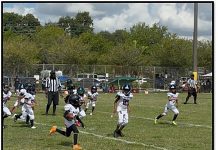The storm is over but the recovery will take longer than the hurricane. Hopefully everyone’s lights are back on as we begin to restore some normalcy to our community. I heard from numerous of you regarding many issues and we tried to address all that were within our power; however, there were some things that were outside of our control. Our city staff and we as your Mayor and Commission tried to provide as much needed assistance as possible by helping to give out water, ice, and in some cases food. For those that need the Temporary Blue
Roofs:
• Operation Blue Roof can make some damaged structures habitable again until more permanent repairs can be made.
• The program, managed by the U.S. Army Corps of Engineers (USACE), provides free installation of blue plastic sheeting on damaged roofs of eligible residences, schools, daycare centers, public facilities and, in some cases, churches and other buildings used as shelters or relief locations to help reduce further damage to property until repairs can be made.
• This program is available at no cost to eligible primary homeowners in Broward, Charlotte, Collier, DeSoto, Glades, Hardee, Hendry, Highlands, Hillsborough, Lee, Manatee, Miami-Dade, Monroe, Palm Beach, Pinellas, Polk, and Sarasota counties.
• Current information is available on the Jacksonville District website at www.saj.usace.army.mil/BlueRoof and at 1-888-ROOF-BLU (1-888-766-3258). Information is provided in both English and Spanish through this single number.
• Here are some important facts about the program:
o The plastic is a reinforced, waterproof material that is designed to last 30 days. We recommend homeowners make arrangements for permanent roofs within 30 days if possible.
o The sheeting can be put only on pitched, asphalt-shingled roofs; damage to the roof must be less than 50 percent and the area to be covered must be structurally sound for a crew to work on safely.
o Metal roofs and mobile homes may be repaired as practical on a case by case basis.
o For rental property, legal permission for a blue roof to be installed must be obtained from the property owner. Renters must also obtain legal permission from their landlord to continue occupying the residence until more permanent repairs are made.
o Property owners must remove any fallen trees from a roof prior to sheeting installation. After it is secured, the sheeting becomes the homeowner’s responsibility to maintain. All blue roofs carry a 30-day warranty.
o Homeowners must sign a Right of Entry (ROE) form to allow government employees and contractors onto their property to assess damage and install the temporary covering.
o ROE collection centers will be set up by Corps teams in convenient neighborhood locations. ROE collection centers are located at:
COLLIER COUNTY
2800 North Horseshoe Dr.
Naples, FL 34104
The Growth Center
310 Alachua St.
Immokalee, FL 34142
LEE COUNTY
Lowe’s Home Improvement
8040 Dani Dr.
Fort Myers, FL 33966
PINELLAS COUNTY
The Outreach Center
12875 Walsingham Rd.
Largo, FL 33774
SARASOTA COUNTY
Bee Ridge Park
4430 South Lockwood Ridge Road
Sarasota, FL 34231
o Collection centers are open from 8 a.m. to 6 p.m. Additional locations may be added as necessary.
o Homeowners can also cover their roof with free tarps provided by FEMA and issued through their local governments. Residents need to monitor the media for information on where to pick up the tarps.
• The plastic covering and the tarps are temporary fixes designed to provide protection from the elements until the homeowner can make permanent repairs with a qualified professional. Listed below is the FEDERAL EMERGENCY MANAGEMENT AGENCY INDIVIDUAL
ASSISTANCE PROGRAMS
Once your county receives an Individual Assistance designation, these FEMA Programs are available to those who are eligible. You are eligible if you are a disaster-impacted individual with expenses not covered by insurance.
Individuals and Households Program
Housing Assistance provides financial and/or direct assistance to eligible disaster survivors who have necessary expenses and serious needs unmet through other resources, such as insurance.
• Financial Housing Assistance can include Rental Assistance, Lodging Expense Reimbursement, Home Repair Assistance, and Home Replacement Assistance.
• Direct Housing Assistance can include Manufactured Housing Units, Multi-Family Lease and Repair, and Permanent or Semi-Permanent Housing Construction.
Other Needs Assistance provides financial assistance to individuals and households who have other disaster-related necessary expenses such as medical, childcare, funeral, personal property, and transportation costs. The U.S. Small Business Administration’s (SBA) Disaster Assistance Program provides low-interest, long-term loans to those impacted by a declared disaster.
Crisis Counseling Assistance & Training Program assists in recovery from the effects of a disaster through community based outreach and psycho-educational services.
Disaster Case Management involves creating a Disaster Recovery Plan together with a disaster case manager to reach disaster recovery by meeting unmet needs through available resources.
Disaster Unemployment Assistance provides unemployment benefits and re-employment services to individuals who have become unemployed because of the disaster and who are not eligible for regular State unemployment insurance.
Disaster Legal Services provides legal assistance to low-income individuals who are unable to secure legal services adequate to meet their disaster related needs.
HOW TO APPLY
• Internet: https://www.disasterassistance.gov
• Smartphone: downloading FEMA application through https://www.fema.gov
• FEMA Toll-Free Helpline: 800-621-3362
• FEMA Toll-Free Helpline for deaf, hard of hearing, or speech disability: 800-462-7585 • Disaster Recovery Center open for limited periods post-disaster near your community.
• U.S. SBA Disaster Loan Assistance: https://disasterloan.sba.gov/ela
Restrictions: Financial assistance is limited to an annually adjusted amount based on the Department of Labor Consumer Price Index. Applicants whose homes are located in a Special Flood Hazard Area and who receive assistance because of a flood-caused disaster must obtain and maintain flood insurance. Disaster survivors may need to provide documentation to help FEMA evaluate their eligibility, such as proof of occupancy, ownership, income loss, and/or information concerning an applicant’s housing situation prior to the disaster.
Assistance is limited to 18 months following the disaster declaration.
God bless you all, stay safe, stay strong, stay focus, for this too will pass.






